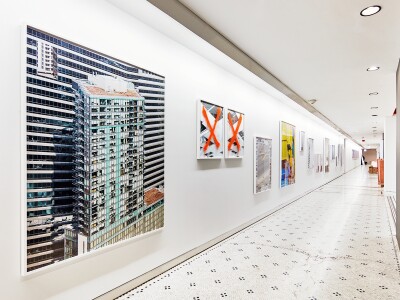A Q&A with Associate Professor Daniel Everett about his featured work
From September 16, 2017 through January 7, 2018, faculty member Daniel Everett will be featured in the second edition of the Chicago Architecture Biennial, an architecture and design exhibition examining the state and future of architecture. Everett, who teaches new genre, photography and advanced studio courses for the Department of Art, discusses the Biennial and his work below.
Q: Tell us about the Chicago Architecture Biennial. How do you get your work there?
A: With each Biennial, they find a curator working at the intersection of architecture and contemporary art to organize an exhibition. Last year I was approached by Jesús Vassallo, an architecture professor at Rice University who has written extensively on art and architecture who had been asked to curate the show for the Biennial. He was interested in hearing more about my work, and ended up inviting me to participate in the Biennial. He was eager that all of the work in the show be new work made in and around Chicago, so in March the Biennial flew me out to make a new body of work.

Q: How did Vassallo know about your work?
A: Jesús had seen a body of work that I had made called Marker that was included in a few publications. He was interested in me making new work following in the same vein, but based in Chicago.
Q: Tell us about the premise for this series. What was your inspiration?
A: About seven years ago I started collecting these brightly painted rocks that I would find on paths, trails or by the side of the road. They had come from construction sites where they use spray paint to mark boundaries or to indicate where utilities would be installed, and had been displaced or repurposed after that. I liked that the rocks bore the marks of the construction process, but as I collected them I wasn’t sure what I was going to do them. Then about a year ago I started arranging and photographing them on nondescript office floors. I was interested in how these rocks that had been marked by the process of progress were left behind. This series was about traces, or evidence of the organizational logic of construction, and how it marks the land.
(My work is) always about this modern alienation, or this idea that perfection might be kind of lonely and underwhelming."]I liked that the rocks bore the marks of the construction process ... I was interested in how these rocks that had been marked by the process of progress were left behind.
In Chicago I ended up photographing quite a few construction sites. I was also able to get permission to photograph interiors in a number of Mies van der Rohe buildings. I wanted to see the original bones and structure of the buildings, but unfortunately over the years they’d been completely redesigned in this palatable, bland office décor. From the outside of course they looked the same as when they were built, but the inside of the buildings had been marked and changed. I ended up photographing small functional alterations within the space, like where they were removing the tiling to replace the ceilings—changes made in preparation for the next iteration of the building. The series also contains a lot of altered images that I’m modifying in noticeable ways through Photoshop, adding layers of marks on top of them or erasing in parts. All of the images are me honing in on these small evidences of spaces in flux, in the process of constructing and deconstructing over time, in pursuit of progress.
Q: What are you exploring through this body of work?
A: In a larger sense all of my artwork deals with utopian promises of modernism — the promises of the future and improvement, but focusing on the banal and mundane objects, buildings and things that are left in the wake of development, this ambivalence toward perfection and order. I’m interested in these meticulously organized structures and all of this visionary kind of planning that results in bland, gray cubes dotting the landscape, or it kind of falls into disrepair, and that vision of the future is never really realized because a new vision of the future replaces it. I’m interested in this accumulation of marks that are all repercussions of this pursuit of the future and progress and order.

Q: Tell us about your work as a whole. What other areas of inquiry are you involved in?
A: I make my work in a very intuitive way and once I’ve made enough images or sculptures or videos that seem to be about a fairly related thing, then I organize them in relationship to one another. But they’re always about this modern alienation, or this idea that perfection might be kind of lonely and underwhelming. They’re always about believing in industry, believing in organization, but also the kind of mundanity that results from these things.
I did a book in 2015, Throughout the Universe in Perpetuity, with pictures of buildings taken all over the world and merged with one another, creating one singular, sprawling, endless city. This series probably comes closest to being a sequel to what I was doing in that series.

